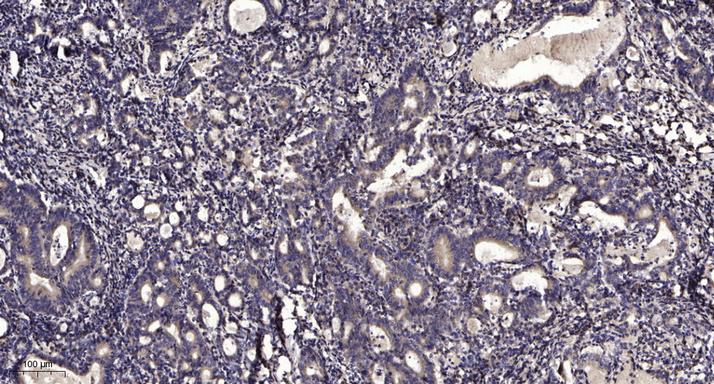Smad2/3 (Acetyl Lys420/378) rabbit pAb
- Catalog No.:YK0167
- Applications:WB;IHC
- Reactivity:Human;Mouse;Rat
- Target:
- Smad2/3
- Fields:
- >>Cell cycle;>>Endocytosis;>>Cellular senescence;>>TGF-beta signaling pathway;>>Apelin signaling pathway;>>Hippo signaling pathway;>>Signaling pathways regulating pluripotency of stem cells;>>Th17 cell differentiation;>>Relaxin signaling pathway;>>AGE-RAGE signaling pathway in diabetic complications;>>Chagas disease;>>Human T-cell leukemia virus 1 infection;>>Pathways in cancer;>>Proteoglycans in cancer;>>Colorectal cancer;>>Pancreatic cancer;>>Hepatocellular carcinoma;>>Gastric cancer;>>Inflammatory bowel disease;>>Diabetic cardiomyopathy
- Gene Name:
- SMAD2 MADH2 MADR2
- Protein Name:
- Smad2/3 (Acetyl Lys420/378)
- Human Gene Id:
- 4087
- Human Swiss Prot No:
- Q15796/P84022
- Mouse Gene Id:
- 17126
- Mouse Swiss Prot No:
- Q62432
- Rat Gene Id:
- 29357
- Rat Swiss Prot No:
- O70436
- Immunogen:
- Synthesized peptide derived from human Smad2/3 (Acetyl Lys420/378)
- Specificity:
- This antibody detects endogenous levels of Human,Mouse,Rat Smad2/3 (Acetyl Lys420/378)
- Formulation:
- Liquid in PBS containing 50% glycerol, 0.5% BSA and 0.02% sodium azide.
- Source:
- Polyclonal, Rabbit,IgG
- Dilution:
- WB 1:500-2000;IHC 1:50-300
- Purification:
- The antibody was affinity-purified from rabbit serum by affinity-chromatography using specific immunogen.
- Concentration:
- 1 mg/ml
- Storage Stability:
- -15°C to -25°C/1 year(Do not lower than -25°C)
- Other Name:
- Mothers against decapentaplegic homolog 2 (MAD homolog 2;Mothers against DPP homolog 2;JV18-1;Mad-related protein 2;hMAD-2;SMAD family member 2;SMAD 2;Smad2;hSMAD2)
- Observed Band(KD):
- 55kD
- Function:
- embryonic axis specification, in utero embryonic development, formation of primary germ layer, mesoderm formation,peptide secretion, generation of a signal involved in cell-cell signaling, regionalization, transcription, regulation of transcription, DNA-dependent, regulation of transcription from RNA polymerase II promoter, RNA processing, protein complex assembly, protein amino acid phosphorylation, phosphorus metabolic process, phosphate metabolic process,cell surface receptor linked signal transduction, enzyme linked receptor protein signaling pathway, transmembrane receptor protein serine/threonine kinase signaling pathway, transforming growth factor beta receptor signaling pathway, SMAD protein complex assembly, intracellular signaling cascade, cell-cell signaling, zygotic determination of dorsal/ventral axis, gastrulation, pattern specification process, mesoderm development, heart
- Subcellular Location:
- Cytoplasm . Nucleus . Cytoplasmic and nuclear in the absence of TGF-beta. On TGF-beta stimulation, migrates to the nucleus when complexed with SMAD4 (PubMed:9865696, PubMed:21145499). On dephosphorylation by phosphatase PPM1A, released from the SMAD2/SMAD4 complex, and exported out of the nucleus by interaction with RANBP1 (PubMed:16751101, PubMed:19289081). Localized mainly to the nucleus in the early stages of embryo development with expression becoming evident in the cytoplasm at the blastocyst and epiblast stages (By similarity). .
- Expression:
- Expressed at high levels in skeletal muscle, endothelial cells, heart and placenta.
- June 19-2018
- WESTERN IMMUNOBLOTTING PROTOCOL
- June 19-2018
- IMMUNOHISTOCHEMISTRY-PARAFFIN PROTOCOL
- June 19-2018
- IMMUNOFLUORESCENCE PROTOCOL
- September 08-2020
- FLOW-CYTOMEYRT-PROTOCOL
- May 20-2022
- Cell-Based ELISA│解您多样本WB检测之困扰
- July 13-2018
- CELL-BASED-ELISA-PROTOCOL-FOR-ACETYL-PROTEIN
- July 13-2018
- CELL-BASED-ELISA-PROTOCOL-FOR-PHOSPHO-PROTEIN
- July 13-2018
- Antibody-FAQs
- Products Images

- Immunohistochemical analysis of paraffin-embedded human Gastric adenocarcinoma. 1, Antibody was diluted at 1:200(4° overnight). 2, Tris-EDTA,pH9.0 was used for antigen retrieval. 3,Secondary antibody was diluted at 1:200(room temperature, 45min).


